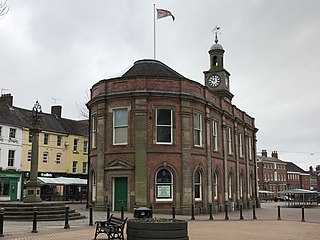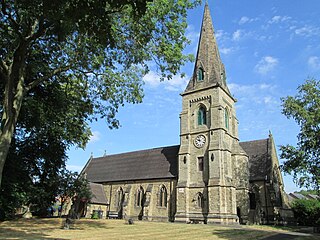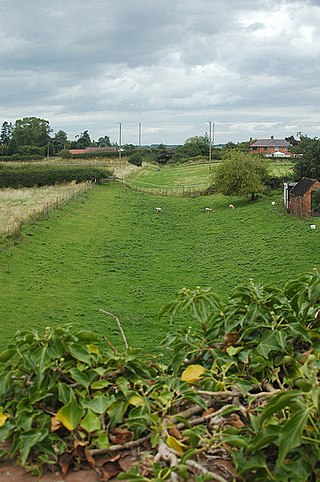
Newcastle-under-Lyme is a market town and the administrative centre of the Borough of Newcastle-under-Lyme in Staffordshire, England. It is adjacent to the city of Stoke-on-Trent. In 2021 the population was 75,082.
The Leek and Manifold Valley Light Railway (L&MVLR) was a narrow gauge railway in Staffordshire, England that operated between 1904 and 1934. The line mainly carried milk from dairies in the region, acting as a feeder to the 4 ft 8+1⁄2 instandard gauge system. It also provided passenger services to the small villages and beauty spots along its route. The line was built to a 2 ft 6 in narrow gauge and to the light rail standards provided by the Light Railways Act 1896 to reduce construction costs.

The North Staffordshire Railway (NSR) was a British railway company formed in 1845 to promote a number of lines in the Staffordshire Potteries and surrounding areas in Staffordshire, Cheshire, Derbyshire and Shropshire.

Keele is a village and civil parish in the Borough of Newcastle-under-Lyme in Staffordshire, England. It is approximately 3 miles (4.8 km) west of Newcastle-under-Lyme, and is close to the village of Silverdale. Keele lies on the A53 road from Newcastle to Market Drayton and Shrewsbury. The village is the location of Keele University and Keele Services, a motorway service area on the M6.
The Stafford and Uttoxeter Railway was authorised by Act of Parliament on 29 July 1862, to build a line between the towns of Stafford and Uttoxeter in Staffordshire, England. It opened for traffic in 1867. It opened on 23 December 1867. Construction cost had much exceeded estimates, and income was poor, so that the company was always in financial difficulty. It was placed in receivership in 1875. The Great Northern Railway (GNR) had running powers to Uttoxeter and was persuaded to acquire the company, which it did in 1881. The GNR spent a considerable sum on improving the line, but it never made money and it was closed to passengers on 4 December 1939. Goods traffic ceased in 1951, except for a short stub to RAF Stafford; this too closed in 1975.

Madeley is a village and ward in the Borough of Newcastle-under-Lyme, North Staffordshire, England. It is split into three parts: Madeley, Middle Madeley, and Little Madeley. Madeley Heath is also considered by many to be part of Madeley. In the 2001 census, the population was recorded as 4,386, decreasing to 4,222 at the 2011 Census.

Silverdale is a village and civil parish in the Borough of Newcastle-under-Lyme in Staffordshire, west of Newcastle-under-Lyme. It is a self contained ward of Newcastle Borough Council returning 2 Councillors. Historically, the village was dominated by the coal industry and records indicate coal was mined in the area as long ago as the 13th century. The last colliery, Silverdale Colliery, closed in 1998. Brick-maker Ibstock also operate a large clay quarry next to the former colliery.
The Wilts, Somerset and Weymouth Railway (WS&WR) was an early railway company in south-western England. It obtained Parliamentary powers in 1845 to build a railway from near Chippenham in Wiltshire, southward to Salisbury and Weymouth in Dorset. It opened the first part of the network but found it impossible to raise further money and sold its line to the Great Western Railway (GWR) in 1850.
The Lampeter, Aberayron and New Quay Light Railway was an independent branch line railway in south west Wales. It connected Aberayron to the former Manchester and Milford Railway line at Lampeter; New Quay was never reached.

The Wye Valley Railway was a standard gauge railway that ran for nearly 15 miles (24 km) along the Lower Wye Valley between the towns of Chepstow and Monmouth, crossing several times between Wales and England. Opened on 1 November 1876, it was leased to, and worked by, the Great Western Railway (GWR), before being fully absorbed by the GWR in 1905.
The Stoke to Market Drayton Line was a railway line that ran through Staffordshire and Shropshire that was built by the North Staffordshire Railway.

The North Wales Mineral Railway was formed to carry coal and ironstone from the mineral-bearing area around Wrexham to the River Dee wharves. It was extended to run from Shrewsbury and formed part of a main line trunk route, under the title The Shrewsbury and Chester Railway. It opened in 1846 from Chester to Ruabon, and in 1848 from Ruabon to Shrewsbury. It later merged with the Great Western Railway.

The Nantwich and Market Drayton Railway was a standard gauge railway line which began as a single line branch in the early 1860s and rapidly became part of the Great Western Railway's (GWR) double track Wellington-Crewe line. It carried through freight and local passenger traffic until its closure in the 1960s. Market Drayton was renowned for the manufacture of gingerbread, hence the line acquired the nickname the "Gingerbread Line".

The Wellington and Drayton Railway was a standard gauge line in Central England which carried through freight and local passenger traffic until closure in the 1960s. It was part of the Great Western Railway's double track Wellington-Crewe line, linking the Midlands to the north and northwest.

Pipe Gate was a railway station on the North Staffordshire Railway's Stoke to Market Drayton Line.
Cold Meece railway station was a short-lived railway station built during the Second World War by the London, Midland and Scottish Railway (LMS) to serve ROF Swynnerton.

The Newcastle & Carlisle Railway (N&CR) was an English railway company formed in 1825 that built a line from Newcastle upon Tyne on Britain's east coast, to Carlisle, on the west coast. The railway began operating mineral trains in 1834 between Blaydon and Hexham, and passengers were carried for the first time the following year. The rest of the line opened in stages, completing a through route between Carlisle and Gateshead, south of the River Tyne in 1837. The directors repeatedly changed their intentions for the route at the eastern end of the line, but finally a line was opened from Scotswood to a Newcastle terminal in 1839. That line was extended twice, reaching the new Newcastle Central Station in 1851.

The Mitcheldean Road and Forest of Dean Junction Railway was an independent railway company incorporated in 1871, to provide a northerly outlet for iron ore and coal products from the Cinderford and Whimsey area in the Forest of Dean, to the Hereford, Ross and Gloucester Railway line; mineral traffic to industrial centres in South Wales and the Midlands was foreseen.

Trentham Gardens railway station was the last station built by the North Staffordshire Railway (NSR) and was the terminus of the short 1 mile 14 chains Trentham Park branch.
The Wellington to Nantwich Railway was a railway line that ran from the Wellington to Nantwich via Market Drayton. The line closed in 1967 to all traffic and the track was dismantled in 1970. The line also connected to the former Stoke-Market Drayton Line at Market Drayton which was a junction station for the line until the closure to Madeley Chord in 1956.












